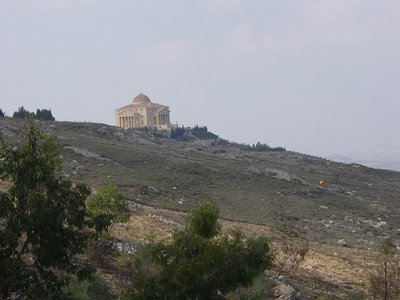 Tra i palestinesi, qualcuno emerge.... anche se suo cugino è ministro dell'Autorità Palestinese e lui ha fatto fortuna costruendo infrastrutture per il governo..
Tra i palestinesi, qualcuno emerge.... anche se suo cugino è ministro dell'Autorità Palestinese e lui ha fatto fortuna costruendo infrastrutture per il governo..In his birthplace of Nablus, he started work on the most spectacular house in the region, a university faculty and a pediatric ward, employing 500 people in construction. His house was built 300 metres above his former home in the kasbah on Mount Gezirim and like hundreds of other Nablus homes it was occupied by Israeli soldiers. In an echo of Israeli settlers, he emphasised the need to build and develop as a political statement. "Where the Israelis destroyed one olive tree, I plant 100. Where they destroy I create," he said. The home which Mr Masri calls the House of Palestine is now finished. It is based on an Italian palazzo in Vincenza and in the garden is a summer house that Napoleon had built for Josephine, which was imported along with most of the building materials from France. In the basement are the preserved mosaics of a Byzantine church, which were discovered during construction. The juxtaposition of wealth on the hill and poverty in the valley could not be stronger but it is a gap that Mr Masri works very hard to bridge. In addition to the large projects he has funded, he is also the patron for a charity that provides for the needs of people whose lives are damaged by Israeli incursions and funds reconstruction of damaged buildings. Mr Masri has been criticised for being part of a group of businesses and businessmen that has a dominating position in the Palestinian economy but it is clear that his interest in investing in his homeland is more emotional and political than financial. One of the companies in which he is a major investor is building a luxury hotel in the Gaza Strip.
descrizione della villa di Al Masri tratta da http://securebar.secure-tunnel.com/cgi-bin...-103552,00.html
 During the War of Independence, the Syrian army reached the gates of Degania Alef, but was bravely repulsed. A burnt Syrian tank remains on the site as a memorial. The two Deganias have a combined population of nearly 1,000. Due to the hot climate and abundance of water, both Deganias are engaged in fully irrigated farming. Degania Bet has also a metal factory
and Kadish Luz were members of Degania Bet. A.D. Gordon, Arthur Ruppin, Otto Warburg and other founders of the labor settlement movement are buried on Degania Alef.
During the War of Independence, the Syrian army reached the gates of Degania Alef, but was bravely repulsed. A burnt Syrian tank remains on the site as a memorial. The two Deganias have a combined population of nearly 1,000. Due to the hot climate and abundance of water, both Deganias are engaged in fully irrigated farming. Degania Bet has also a metal factory
and Kadish Luz were members of Degania Bet. A.D. Gordon, Arthur Ruppin, Otto Warburg and other founders of the labor settlement movement are buried on Degania Alef.
Nessun commento:
Posta un commento